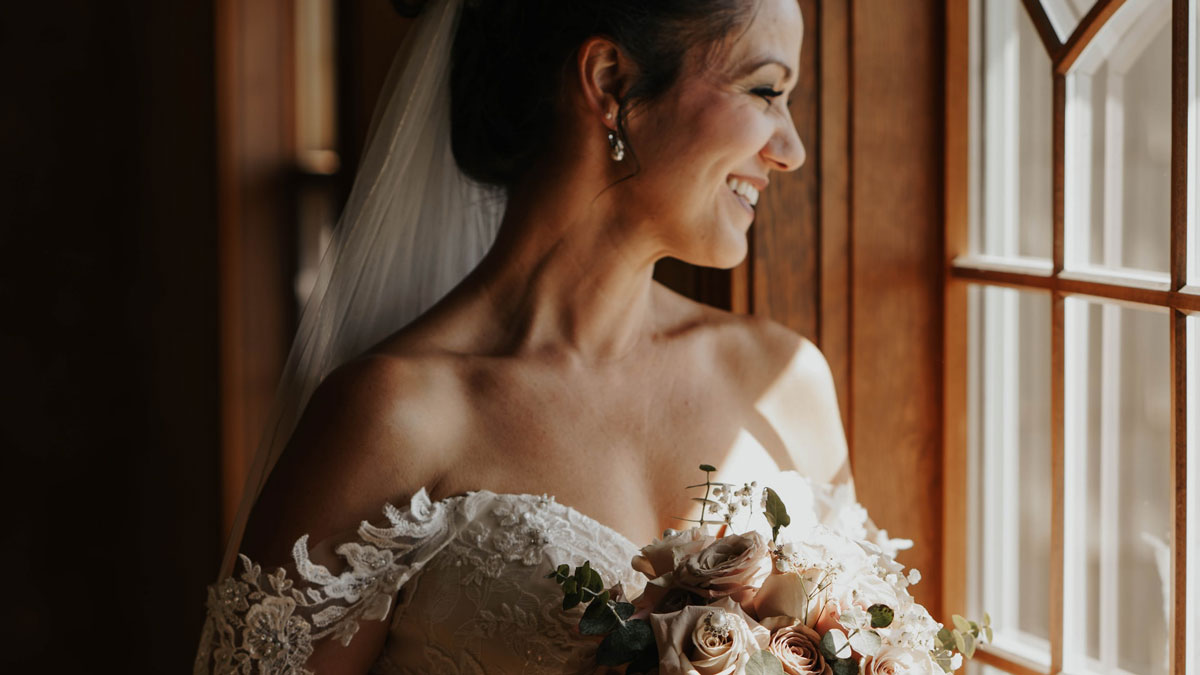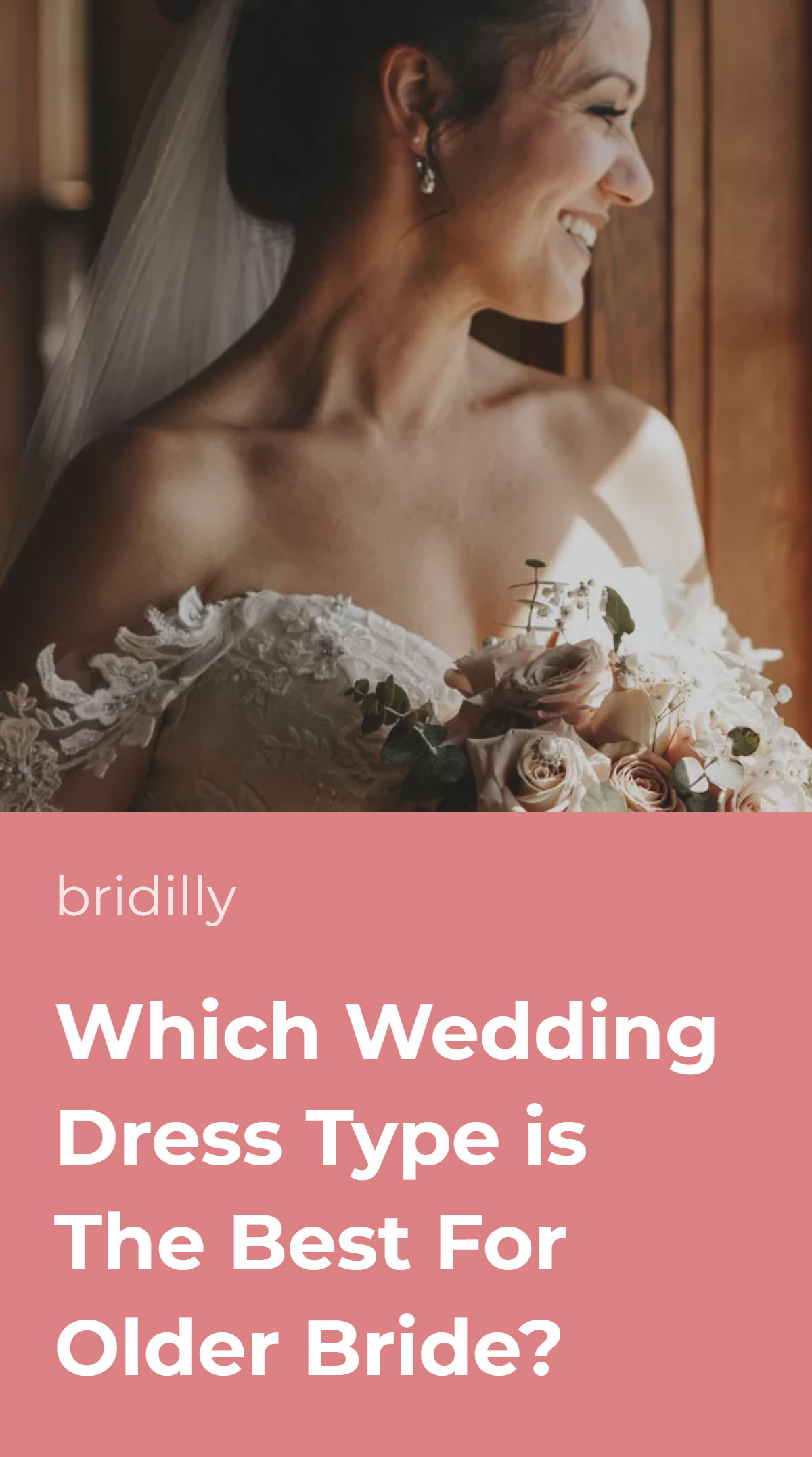Choosing an appropriate wedding dress for an older bride may seem difficult, but that’s only true if you’re tied with societal prejudices.
The truth is, your wedding dress selection is nearly limitless, and age shouldn’t be the main factor in your decision-making.
Your choice of wedding gown should be merely based on your individual figure peculiarities and style preferences. If you have great legs or arms, you can show them at 40, 50, and 60.
However, some designs may be more suitable for an elegant age: modest high necklines, sophisticated three-quarter sleeves, and feminine tea-length hemlines are some of the best wedding dress styles for older brides.
Most importantly, you should stay true to yourself and choose a dress that speaks to your heart. Your real age is determined by your inner state, not figures in your passport.
Table of Contents [show]
Choose Right Fabrics
Your wedding dress fabric can make your look or ruin it, so choose fabric quality over design intricacy. A wedding gown for an older bride shouldn’t be made from thin, stretchy fabric, as it will show all your lumps and bumps.
Tight dresses from stretchy fabric rarely suit even young girls. The same applies to semi-see-through fabrics such as chiffon and mesh.
They’re great for layered skirts or details such as sleeves but shouldn’t comprise your entire dress.
See-though fabrics will showcase all your body imperfections, including wrinkles and stretch marks. Instead, choose opaque fabrics from natural fibers, such as cotton, charmeuse, silk, and crepe.
Damask, faille, gazar, taffeta, and brocade are some truly gorgeous fabrics with an interesting texture that can turn even the most minimalistic dress into a classy formal style.
Synthetic fabrics such as polyester and rayon are also possible, though they should be of high quality.
Your wedding dress fabric should be opaque and thick enough to conceal imperfections but not overly heavy as it may make you perspire.
Sleeves or Sleeveless?
A common misconception is that women over 50 (according to some opinions, even 30) shouldn’t wear sleeveless and strapless dresses. That’s an outdated rule – you don’t have to cover up unless you want to.
Of course, the skin becomes less elastic with age, and arms may look not as appealing as at a younger age. Furthermore, many women gain weight over time.
But this doesn’t make every older woman equal and doesn’t mean that young girls always have flawless arms.
If you stay toned and think that you look great, there’s no harm in choosing a sleeveless dress – especially if your wedding is in summer.
If you’re concerned about your arms or some guests thinking a sleeveless dress is inappropriate but don’t want to perspire, choose dresses with cap sleeves.
Flutter sleeves are another feminine and romantic wedding dress sleeve style for older brides.
Three-quarter sleeves are a perfect option for spring, autumn, or winter weddings.
They will keep you warm and beautifully elongate the arms, concealing imperfections. Furthermore, that’s one of the most elegant sleeve styles of all time.
Lastly, if you really admire strapless gowns but are looking for a more comfortable option, consider illusion sleeves. Note that mesh or lace won’t let the dress fall but also won’t hide much.
Add Some Color
White is associated with purity and innocence, so older women sometimes are hesitant to wear a white wedding dress. However, there’s no rule stating that you shouldn’t wear it – after all, it’s a traditional wedding dress color.
If you’re concerned about the symbolism, are over the “white ball gown with a long train” phase, or simply find it too unoriginal, add some color.
Blush, grey, light blue, and champagne are some of the most popular white wedding dress alternatives.
If you’re looking for a more creative color, consider yellow and green – a correctly chosen shade can make your complexion glow better than makeup. Gold, rose gold, and silver wedding dresses are great for the most confident brides.
The truth is, you can choose any wedding dress color that suits your personality. Your selection is limitless, and you aren’t tied with parent expectations like many younger brides.
Consider Your Body Type
Age shouldn’t be your main concern when choosing a wedding dress. Each woman is different, so there’s no universal solution that fits all.
Consider your body type when choosing the wedding dress silhouette. Which body parts are you proud of, and which you’d prefer to hide?
Classic A-line wedding dresses are the most complimentary style, as they suit any body type, accentuating the waist but not squeezing it like corset gowns.
Brides with apple and rectangle body types should avoid mermaid silhouette, as it can make the waist wider.
Ball gowns aren’t the best option for petite brides as they tend to make the figure bulkier and shorter but look stunning on tall women. Sheath and slip dresses suit slim brides with toned arms.
Choose a straight silhouette with accent sleeves or bust if you’d like to balance wide hips. And if you wish to hide the tummy, consider an empire gown.
Modest Styles
If you believe that with age comes responsibility and 50-year-old brides shouldn’t wear the same styles as 20-year-olds, your selection is still plentiful. Today, you can easily find a modest yet gorgeous wedding gown.
Modest wedding gowns are usually long, with sleeves and a high neckline. However, this doesn’t mean that you should conceal the body entirely – combining two out of three elements is enough.
For instance, you may look for styles with an accent belt, illusion sleeves, or a tea-length skirt. A boat neckline dress with three-quarter sleeves and a midi skirt is one of the most elegant and modest wedding dress styles.
Flattering Necklines
Older brides rarely choose wedding dresses with a revealing plunging neckline. No one’s prohibiting you from showing cleavage if you’re confident enough, but some more modest necklines are no less flattering.
Boat, square, V-cut, and scoop necklines are all-time wedding dress classics. High neck and queen Anne necklines are impeccably chic and dramatic, while halter and asymmetric styles are modern and stylish.
Be careful with sweetheart, straight across, and off-shoulder necklines – they require great bust and arm skin condition and a lot of confidence. Furthermore, such dresses tend to slip off when you’re moving.
Choose Fit Over Trends
Styles with sexy cut-outs, two-piece attires with crop tops, and voluminous dresses from see-through fabrics are on the surge. However, you shouldn’t blindly follow fashion trends – instead, focus on the dress fit.
It’s best to pay extra for dress fitting than for a famous designer name – that’s a universal rule, but it’s especially important for older brides. Proper fitting will ensure that you look stunning and feel confident on your wedding day.
A well-fitted dress will smooth all lumps and enhance your figure’s good sides. Meanwhile, you don’t have to refuse from trends completely – some of them are appropriate for brides of any age and body type.
For instance, some of the hottest wedding dress trends of recent years are balloon sleeves, bell sleeves, high neck, unusual colors, high-low skirts, and bridal suits.
All these styles will suit older brides and make them look extremely modern.
Vintage Dresses
Vintage and vintage-inspired wedding gowns often feature timeless, sophisticated designs that look great on older brides. They tend to be more modest than modern dresses and carry a unique romantic chic.
Your mother or grandmother may have preserved their wedding dresses, or you may find some online. Vintage clothes are gaining popularity, so finding a style you admire shouldn’t be difficult.
Vintage wedding dresses usually have traditional white or ivory colors, but the fabric may become yellowish over time. You may have to pay for professional dry-cleaning and color restoration if you buy a vintage dress.
Every era has different trends, so you can easily identify the age of some dresses by certain elements.
So, dresses from the 1920s’ often have knee-length hemlines and dropped waist. The 1940s’ are characterized by glamour chic, extra-long hemlines, and voluminous sleeves.
During the 1960s’, wedding dresses started to become more diverse and more similar to modern styles. However, tea-length and mini dresses with minimalistic decorations were the trendiest options.
Brides from the 1970s’ admired halter necks and pants, and in the 1980s’, shoulder pads and high necks came into play.
As you can see, vintage styles are very different, but most are much more modest and appropriate for older brides than some modern designs.
Short, Midi, or Long?
Though most older brides prefer floor-length styles, wedding dresses come in all shapes and lengths. If a long dress is what you truly wish, go for it – but if legs are your best feature, consider tea-length or knee-length dresses.
Midi length has numerous advantages: it’s comfortable to move in, looks impeccably elegant, and allows you to showcase your great wedding shoes (why buy new expensive heels if no one sees them?).
Calf-length hemlines are very common in vintage dresses and are perfect if you wish to recreate the 1960s’ style.
Mini isn’t the best choice for a wedding dress, and the reason isn’t your age but rather event formality.
You likely would be surprised to see your wedding guests in mini skirts, so leave overly short hemlines for your honeymoon vacation.


















No Comments Add one
Leave a Comment